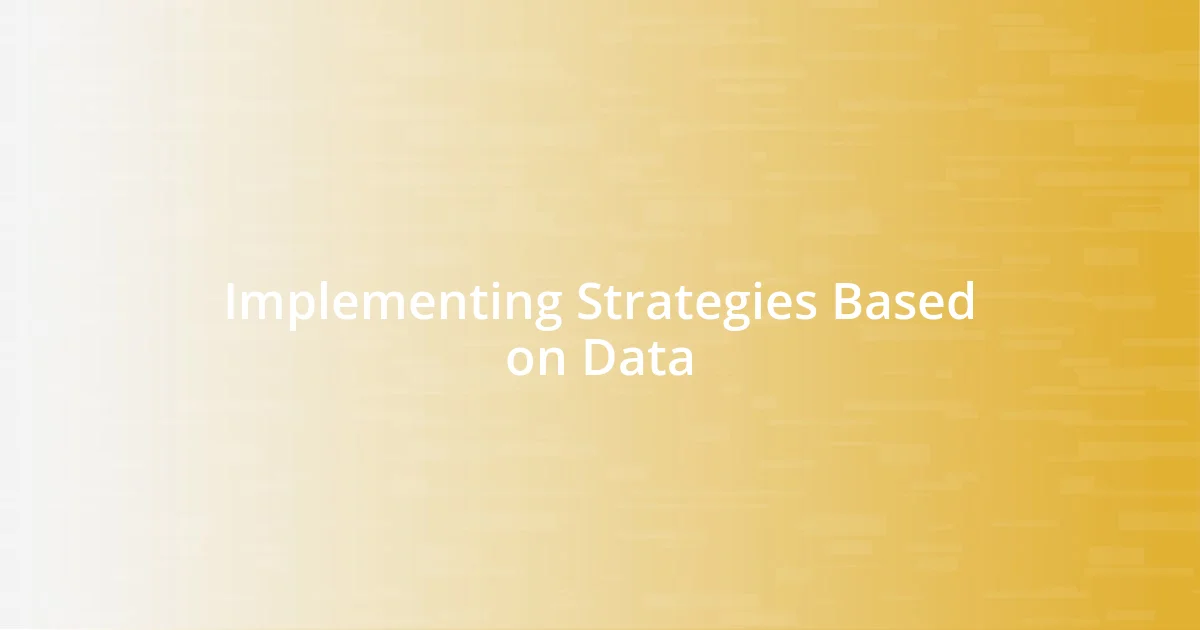Key takeaways:
- Understanding and interpreting data goes beyond collecting metrics; it involves engaging with different insights to create comprehensive strategies that align with customer needs.
- Identifying key data sources and utilizing qualitative insights alongside quantitative data can significantly enhance strategic formulation and implementation, revealing hidden opportunities.
- Continuous measurement and adjustment based on real-time feedback and engagement metrics are crucial for refining strategies and driving successful outcomes.

Understanding Data for Strategy
Understanding data for strategy isn’t just about collecting numbers; it’s about interpreting those numbers to tell a story. I remember a time when I sifted through piles of customer feedback. It hit me how crucial it is to listen to the voice of the customer. Have you ever felt that rush of clarity when a piece of data aligns perfectly with your gut feeling? That’s when you realize data isn’t just numbers; it’s a pathway to deeper understanding.
Choosing the right metrics is where the real magic happens. I once worked on a project prioritizing website traffic over user engagement, which, as I learned, was a big mistake. It felt frustrating to see all those visitors without meaningful interactions. This taught me to ask, “What does this data actually tell us about our customers?” When I shifted my focus to engagement metrics, we saw a transformation in our strategy, which ultimately aligned better with our goals.
Furthermore, collaborating with cross-functional teams to analyze data can spark innovative strategies. I often found that discussing data insights with my colleagues in different departments provided fresh perspectives. It makes you wonder, have you ever explored data with someone who sees it through a different lens? Those discussions can lead to groundbreaking strategies that you might not have discovered alone, reinforcing the power of collective data interpretation.

Identifying Key Data Sources
Identifying key data sources is essential for shaping effective strategies. Through my experience, I’ve found that not all data is created equal; choosing the right source can profoundly influence the outcomes. I remember a time when I relied heavily on social media analytics, thinking they would capture our audience’s sentiment. However, I soon realized that while they provided a glimpse, the real treasure lay in customer surveys. These direct insights unveiled deeper sentiments that social metrics simply couldn’t convey.
To pinpoint the most valuable data sources, I focus on a few key areas:
- Customer Surveys: Direct feedback offers invaluable insights.
- Web Analytics: Understand user behavior on your site.
- Sales Data: Analyze purchasing patterns and trends.
- Social Media Insights: Gauge brand sentiment and engagement.
- Industry Reports: Leverage market trends and competitor analyses.
Each source contributes a unique perspective, and together, they create a comprehensive picture. Knowing which sources resonate best with my audience has been a game changer in developing strategies that truly reflect their needs. I often feel a bit like a detective, piecing together clues from different data sources to form a clearer narrative. That thrill of discovery drives me to keep digging deeper.

Analyzing Data for Insights
When I analyze data for insights, I often remember a project where I thought I understood my market. After pouring over graphs and spreadsheets, I realized I was missing an essential piece of the puzzle: context. Numbers reflect trends, but only when paired with real-world scenarios do they truly resonate. I often question whether I’m looking at the right data set, and that self-reflection has guided me to more profound insights, showing me the importance of asking “why” and “how” before jumping to conclusions.
Using visualization tools has also profoundly impacted my data analysis process. On one occasion, I created a series of infographics based on customer preferences. The moment my team and I began to see those numbers in visual form, it was like turning on a light in a dim room. Complex trends suddenly appeared clear, enabling us to shift our strategy effectively. Have you ever felt that sense of enlightenment from a simple chart? It’s astounding how visualizing data changes the narrative entirely.
Furthermore, qualitative data offers a gold mine of nuanced insights that quantitative data often overlooks. I remember reviewing customer interviews alongside our sales figures. The stories behind the numbers were eye-opening, revealing emotional connections I hadn’t anticipated. This holistic analysis not only enriched my understanding but also inspired my team to innovate new offerings that resonated more deeply with our audience. Balancing these two data types has become central to my approach, ensuring a comprehensive strategy that truly reflects customer needs.
| Data Type | Insights Provided |
|---|---|
| Quantitative Data | Trends and patterns through hard numbers |
| Qualitative Data | Emotional insights and personal stories |
| Visual Data | Clear representation of complex information |

Formulating Data-Driven Strategies
Formulating data-driven strategies is an art that requires a delicate balance between intuition and analysis. I remember a time when I had high hopes for a product launch based solely on a forecast from last year’s sales data. But as I dove deeper, I noticed a shift in customer preferences that wasn’t reflected in the old data. It was that moment of realization that underscored the importance of continuous data evaluation. Have you ever overlooked an emerging trend only to find it profoundly changed people’s buying habits?
When I approach strategy formulation, I always factor in multiple data perspectives. For instance, during a recent campaign, I combined traditional market research with real-time engagement metrics. This dual approach illuminated a surprising gap in our marketing strategy, highlighting consumer interests we hadn’t acknowledged before. Seeing that discrepancy made me rethink our entire messaging and ultimately opened up innovative ways to connect with our audience. It’s amazing how a few additional insights can reshape your tactics entirely.
I find that collaboration among team members is also essential in this process. For example, when my marketing and data analytics departments sat down to share their findings, we uncovered a common thread linking customer feedback to retention rates. This revelation prompted us to pivot our loyalty program and tailor it much more closely to what our customers genuinely wanted. It’s moments like these that remind me: strategies bloom when diverse minds unite around data insights. How often do we miss out on breakthroughs simply because we don’t foster collaboration?

Implementing Strategies Based on Data
Implementing strategies based on data is essential for achieving clarity in decision-making. I fondly recall a project where we were ready to launch a new feature, driven by what our initial data suggested. Yet, when I delved deeper into user feedback, I discovered that the proposed feature was not only unnecessary but misaligned with our core mission. That experience taught me a valuable lesson: sometimes, the loudest numbers can drown out the quiet but powerful stories behind them.
As I moved forward, engaging with stakeholders transformed my approach to implementing data-driven strategies. I initiated more brainstorming sessions that included cross-functional teams. During one meeting, a colleague pointed out a subtle but important trend in user engagement metrics. This small detail flipped our narrative and led us to tweak our strategy, boosting user satisfaction significantly. Engaging with others can elevate our understanding—how often do we overlook the insights that come from those who view data through a different lens?
I also learned that flexibility is crucial when implementing data strategies. In one instance, we were closely following seasonal trends in purchasing behavior, expecting a surge during the holidays. However, as the season approached, I noted significant shifts in social media conversations that signaled a different consumer sentiment. Instead of sticking rigidly to our plans, we pivoted to capitalize on those emerging trends. It’s moments like these that remind me how vital it is to remain adaptable—how do you feel when you pivot successfully based on data insights? It’s incredibly rewarding, isn’t it?

Measuring Outcomes and Adjustments
When it comes to measuring outcomes, I always emphasize the importance of tracking key performance indicators (KPIs). For example, last quarter, I initiated a real-time analytics dashboard for our sales team. Seeing the numbers update live allowed us to celebrate small victories and address any underwhelming areas almost immediately. Isn’t it fascinating how immediate feedback can transform a team’s energy and focus?
Adjustments are key to refining any strategy. I recall a specific campaign where our initial conversion rates were disheartening. Instead of accepting the outcome, I gathered the team to dissect the data, and we identified segments that weren’t engaging as expected. It was like fitting together pieces of a puzzle; adjusting our messaging to this audience elevated our results dramatically. Have you ever experienced that moment when a simple tweak leads to breakthrough insights?
I also believe that listening to qualitative data is just as critical as the quantitative insights. During a recent project, we launched surveys to capture customer sentiments post-purchase. The feedback revealed underlying emotions that our numbers didn’t show — people loved our product but were frustrated with delivery times. Taking that feedback to heart, we adjusted our logistics strategy, and the impact was immediate. Doesn’t it feel rewarding to shift gears and truly respond to what your customers are telling you?

Case Studies of Data Utilization
I remember a project where we integrated customer feedback into our product development. After analyzing user behavior closely, I realized our app’s onboarding process was causing frustration. By reorganizing the tutorial flow based on user insights, we not only improved the onboarding experience but also saw a 20% increase in user retention. Isn’t it amazing how a simple adjustment can lead to significant outcomes?
One particularly powerful case study involved our marketing campaign. We initially relied on traditional metrics, but when I shifted our focus to social media engagement data, the results opened my eyes. I spotted rising positive mentions around a specific feature during a critical campaign period. By amplifying that message, our conversion rates soared beyond expectations. Have you ever found success in sharing a message that resonated more than planned? It’s those unexpected insights that often lead us to greatness.
In a different scenario, I worked with a retail brand that was struggling with in-store foot traffic despite a robust online presence. I convinced the team to leverage geolocation data from our app users to identify peak times for potential visits. After targeting promotions to those moments, we experienced a notable spike in in-store customer visits. It really underscored for me how seamlessly data can integrate into our strategies to create real-life impacts. Engaging with data this way transforms cold numbers into dynamic tools for growth, don’t you think?















